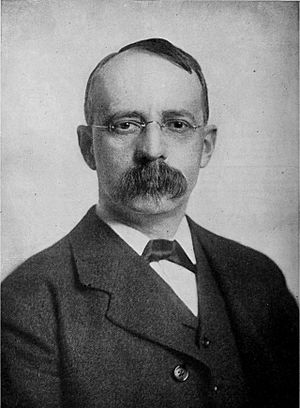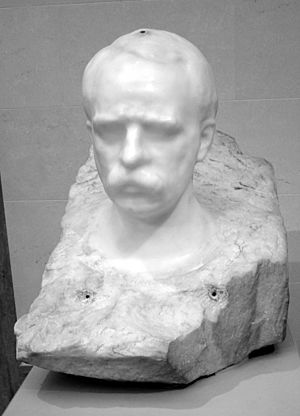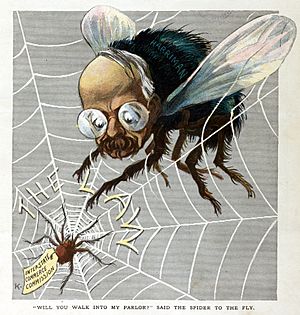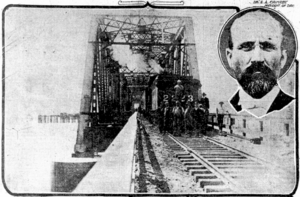E. H. Harriman facts for kids
Quick facts for kids
E. H. Harriman
|
|
|---|---|
 |
|
| Born |
Edward Henry Harriman
February 20, 1848 Hempstead, New York, U.S.
|
| Died | September 9, 1909 (aged 61) Orange County, New York, U.S.
|
| Resting place | St. John's Church Cemetery, Arden, New York |
| Occupation |
|
| Known for | Harriman Alaska expedition |
| Spouse(s) | Mary Williamson Averell (m. 1879) |
| Children | Mary Harriman Rumsey Henry Neilson Harriman Cornelia Harriman Gerry Carol A. Harriman William Averell Harriman Edward Roland Noel Harriman |
| Relatives | Anne Harriman Vanderbilt (cousin) Oliver Harriman Jr. (cousin) J. Borden Harriman (cousin) Herbert M. Harriman (cousin) |
Edward Henry Harriman (born February 20, 1848 – died September 9, 1909) was a very important American businessman. He was known for his work with railroads and for being a smart investor. He became one of the most powerful people in the railroad industry during his time.
Contents
Early Life and First Steps in Business
Edward Henry Harriman was born on February 20, 1848, in Hempstead, New York. His father, Orlando Harriman Sr., was a church leader. His mother was Cornelia Neilson.
When he was a young boy, Harriman worked at the Greenwood Iron Furnace. This area later became Harriman State Park. At just 14 years old, he left school to work as an errand boy on Wall Street in New York City. Wall Street is famous for its financial businesses. By the time he was 22, he was a member of the New York Stock Exchange. This meant he could buy and sell stocks and shares.
Building a Railroad Empire
Harriman's interest in railroads grew because his father-in-law was the president of a railroad company. In 1881, when Harriman was 33, he bought a small, struggling railroad called the Lake Ontario Southern Railroad. He changed its name and made it profitable. Then, he sold it for a good amount of money. This was the start of his career. He became known for taking railroads that were not doing well and making them successful again.
In 1897, Harriman became a director of the Union Pacific Railroad. He was almost 50 years old. By 1898, he was in charge of the executive committee. From then until his death, his decisions guided the Union Pacific system. In 1903, he became the company's president.
From 1901 to 1909, Harriman was also the president of the Southern Pacific Railroad. He dreamed of combining the Union Pacific and Southern Pacific railroads. These two large railroad companies were finally joined together in 1996.
When Harriman died, he controlled many important companies. These included the Union Pacific, Southern Pacific, and Illinois Central railroads. He also controlled the Pacific Mail Steamship Company and the Wells Fargo Express Company. His fortune was estimated to be between $150 million and $200 million. He left all of this money to his wife.
Harriman Alaska Expedition
In 1899, Harriman paid for and joined a scientific trip to Alaska. The goal was to study the plants and animals along the Alaskan coast. Many famous scientists and nature experts went on this expedition. They traveled on a large, fancy steamer ship called the SS George W. Elder.
Interest in Ju-Jitsu
Harriman became interested in ju-jitsu after visiting Japan in 1905. When he came back to America, he brought six Japanese ju-jitsu wrestlers with him. These included famous judokas Tsunejiro Tomita and Mitsuyo Maeda. They gave many performances, including one at Columbia University in New York City. About 600 people came to watch.
Personal Life and Family
In 1879, Harriman married Mary Williamson Averell. Her father was a banker. Edward and Mary had six children together:
- Mary Harriman (1881–1934)
- Henry Neilson Harriman (1883–1888), who died young.
- Cornelia Harriman (1884–1966)
- Carol Averell Harriman (1889–1948)
- William Averell Harriman (1891-1986), who became a very important politician. He was the Secretary of Commerce and the 48th Governor of New York. He also served as a U.S. Ambassador.
- Edward Roland Noel Harriman (1895–1978)
Harriman passed away on September 9, 1909, at his home called Arden. He was 61 years old. John Muir, a famous naturalist who went on the Alaska expedition with him, admired Harriman greatly. Harriman was buried in a cemetery near his home.
Harriman Estate
In 1885, Harriman bought a large property called "Arden" in New York. It was about 7,863 acres. Over the next few years, he bought much more land nearby, adding another 20,000 acres. He built 40 miles of paths to connect all the land. His huge house, Arden House, was finished just seven months before he died.
In 1910, after Harriman's death, his wife donated 10,000 acres of land to New York State. This land became Harriman State Park. The estate was recognized as a special historical place in 1966.
Harriman's Lasting Legacy

Edward H. Harriman left behind a significant legacy.
Awards and Recognition
- In 1913, his wife created the E. H. Harriman Award. This award recognizes outstanding achievements in railway safety. It has been given out every year since then.
Places Named After Harriman
Many places are named in honor of Edward H. Harriman:
- Harriman, New York
- The Union Pacific Harriman Dispatch Center in Omaha, Nebraska
- Harriman Glacier in Alaska's Chugach National Forest
- Two post offices in Oregon, including one at Rocky Point
- The city of Sparks, Nevada, was once known as Harriman.
- Harriman State Park in Tuxedo, New York
- Harriman State Park in Island Park, Idaho
Projects Funded by Harriman's Estate
- Harriman started the Tompkins Square Boys' Club in 1876. This club, now known as The Boys' Club of New York, provided a safe place for boys. Harriman wanted to "get them off the streets and teach them better manners." He bought land and built a five-story clubhouse for the boys.
- Taxes from Harriman's estate helped fund the construction of Utah's state capital building.
See also
 In Spanish: E. H. Harriman para niños
In Spanish: E. H. Harriman para niños
- List of railroad executives




